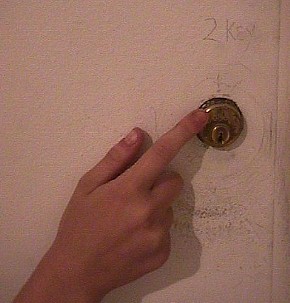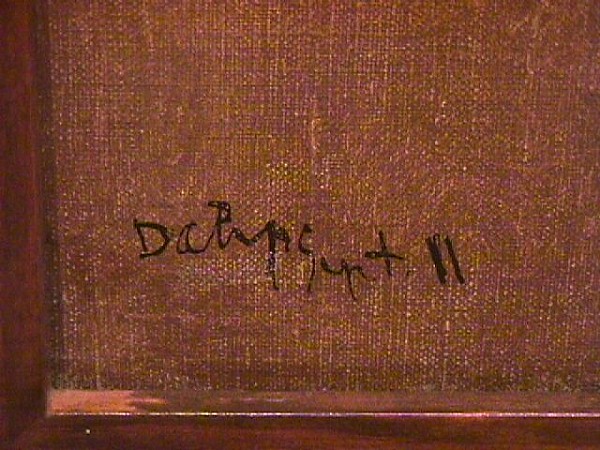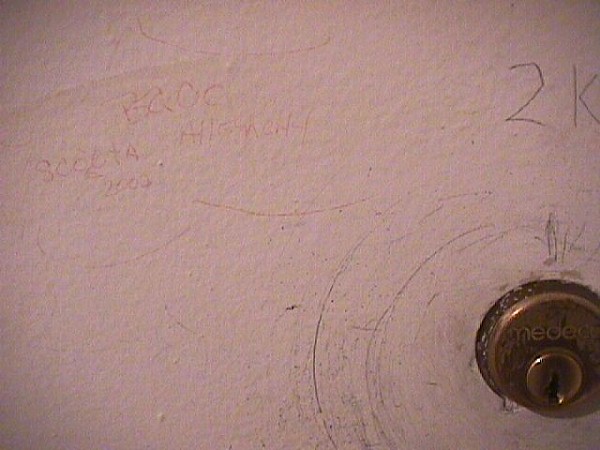2002.07.10 17:08
Étant donnés' Back Door, etc.
Do you know Étant donnés' back door and that it takes "2 key" to open it?

Étant donnés' back door plays an integral role within "Projects for Quaestio Abstrusa Fashions."
ps
Might not the window installed at the Philadelphia Museum of Art by request of Duchamp for the gallery of The Large Glass be considered a heretofore unacknowledged Duchamp work?
2002.07.15 15:10
Re: Étant donnés' Back Door, etc.
The "2 KEY" was already scratched into the door at the Philadelphia Museum of Art. I don't know anymore about why it is scratched there; I assume the doors needs "2 KEY" to open it. Anyway, I'm intrigued by the idea that "Étant donnés' back door" is a "museum piece" without anyone realizing it is a museum peice.
2002.07.15 21:38
Re: Étant donnés' Back Door, etc.
I am not familiar with Duchamp und die Anderen. Does Daniels write at all about the classical sculptural group within the (exterior) museum pediment above and on axis with the window to the Duchamp gallery at the Philadelphia Museum of Art? This sculptural group, a rare reenactment of classical antique polychromy, represents sacred and profane love via mythological characters. I've been wondering whether Duchamp knew of the symbolism of this group while he was arranging the interior disposition of the Arensberg collection, and specifically the room for the Duchamp collection, and hence the specially installed window.
In any case, I like to think of The Large Glass as a confirming furtherance of the sacred/profane love axis at the PMA. (I wonder where Yara is these days.)
| |
2002.09.15 15:10
Re: yvonne and magdelene torn in tatters

I looked at Yvonne and Magdeleine Torn in Tatters at the Philadelphia Museum of Art this afternoon, and took some digital snapshots of the painting as well. Later, at home, looking at a close-up image of the painting's signature, I notice it is signed "Duchamp Sept. 11". I found out the date means September 1911, but I still think the coincidence is interesting. Perhaps I'll start referring to the quondam World Trade Center towers as Yvonne and Magdeleine.
There is a special Richard Hamilton Museum Studies 6 exhibit within the PMA Duchamp gallery. I might upload some images of the exhibit at Museumpeace next month.
Someone has left additional graffiti on Étant donnés' back door--"BAOC Scoota Allegheny 2002". This graffiti was not there about a month ago.

| |
2002.10.08 16:34
Museum Trip 2001.03.25
Museum Trip 2001.03.25 entitles a display beginning at xxx.htm comprising a series of images recorded at the Philadelphia Museum of Art on 25 March 2001. These images, rendered here at approximately the size of side images on a light table, are ordered in the exact sequence that they were taken. More than half of the images depict an investigation of what other works of art at the Philadelphia Museum are axial with The Large Glass. For example, immediately adjacent the Duchamp gallery are galleries containing the works of Brancusi and Twombly respectively. Directly above the Duchamp gallery is a room by 18th century Scottish architect Robert Adam. In the museum's other wing across the courtyard is a fine collection of American glass, (a fitting symmetrical counterpoint to The Large Glass), a collection of Pennsylvania German artifacts, and on the floor above a selection of temples from the Orient.
Inspiration for this investigation derives from the very strong axial relationship between Duchamp's The Bride Stripped Bare By Her Bachelors, Even and Jennewein's Western Civilization as clearly manifest on the Philadelphia Museum of Art's northern courtyard facade, as well as the quondam axial relationship between The Large Glass and Martin's Yara. Museum Trip 2001.03.25 further considers the other axial, albeit by chance, occurrences at Philadelphia with regard to The Large Glass, and, as chance would have it, it was during the recording of the Brancusi gallery that the chance 'discovery' of Etant Donnés inscripted back door occurred.
2002.10.25 19:50
Re: The GREATMAN
Frank Zimmerman wrote in closing:
i kan hardly waite for 'ZTiffAN' to hurll hiz VORboze into THiz MIXX-KAN U & by the TIme 'THe RAiny-BUFfollow putzz IT toGETHER WE'll B zunning OURzelvez-a LONGway from PHillee'
Steve replies:
I could be cute and say I really should delay any 'hurl' coming from my direction, or more specifically from my Philadelphia position, but the truth is that I enjoy this bulletin board and it ongoing postings. I enjoy the stimulation as well as the open opportunity engendered by the bulletin board. Of course, this is because I even more enjoy the stimulation and open opportunity engendered by Duchamp and his works.
My first visit to the Philadelphia Museum of Art (in 1972 when I was a sophomore in high school) was spurred on by Life magazine's feature of the world's largest painting by Gene Davis. It was on that first visit that I at least remember seeing The Large Glass for the first time, but with no prior knowledge of it or Duchamp--perhaps in retrospect experiencing a kind of loss of virginity in the process, yet also oddly not knowing then who was ultimately "f-ing" with me. I wasn't crazy about what I saw, but the full title of the piece did indeed "tickle" me. Beyond that, I can now only guess that I probably didn't see into Étant Donnés that first visit, thus I probably saw the door, but didn't know to look inside.
Sometime it seems like a lot has happened (with me) in the 30 years since then, and sometimes it seems that maybe not enough happened since then. And then even delay becomes an issue, and I suppose that's appropriate (or is it just cute?).
One work at the PMA that I clearly remember from my first visit is the very early Picasso Self Portrait in its collection (currently on an exhibition tour). Picasso was still alive then, but he died the next year. I remember how Time magazine began it report of Picasso's death, something to the effect of moving from "Picasso IS the greatest artist of the 20th century to Picasso WAS the grestest artist of the 20th century."
I've just now been inspired to consolidate my Philadelphia Museum of Art focus via (working title) Reenacting Triumph on Fairmount, Even
| |
2002.11.11 14:09
positioning Étant Donnés [wavelengths]
[from Jennifer Gough-Cooper's chronology (Ephemerides) within Marcel Duchamp: Work and Life (1993) with notes/questions by myself]:
6 May 1949. Philadelphia ...and Duchamp makes detailed notes on the architecture of the different rooms [of the Philadelphia Museum of Art where the Arensberg Collection ultimately ends up].
I wonder if these detailed notes still exist somewhere, and whether they might offer an indication that Duchamp in 1949 at least knew of the space in the PMA where Étant Donnés is ultimately housed.
20 March 1961. Philadelphia In the evening, with Katherine Kuh as moderator, Duchamp, the sculptor Louise Nevelson, and two painters, Larry Day and Theodoror Stamos, are members of a panel to discuss "Where do we go from Here?" at the Philadelphia Museum College of Art.
Of the panelists, Duchamp is the only one to make a prepared statement. [The 20 paragraph statement is published in full within the chronology and ends with, "The great artist of tomorrow will go underground."
Roger LaPelle, in Tout Fait's Notes issue 1, no. 3, writes of Duchamp's visit/lecture at the Pennsylvania Academy of Fine Arts in 1962 where Duchamp refers to himself as an "underground artist."
[I was in Philadelphia on 20 March 1961, but I was not listening to Duchamp downtown, rather, I was at home celebrating my 5th birthday (no kidding), and I distinctly remember thinking at the time, "where do I go from here? (just kidding)]
Has the above mentioned text been published anywhere else beside the Gough-Cooper chronology? It is a very provocative/prescient late Duchamp text.
31 March 1968. New York [the entry ends with] However, the question of the ultimate presentation of Etant donnes preoccupied Marcel. He finally decided that the one person who might help him solve this problem was Bill Copley. When Marcel first told him the story of the piece Bill could not wait to see it, and readily accepted to present the "demountable approximation" in the name of the Cassandra Foundation to the Philadelphia Museum of Art, if the trustees would accept it.
What I am interested in is whether Duchamp's involvement in the installation of the Arensberg Collection (roughly 1949 to 1954) at the Philadelphia Museum of Art has any direct bearing on the on-going creation and ultimate position/presentation of Étant Donnés. I'll pursue all this (I hope) at the PMA library, but if there is already a published study of Duchamp's role vis-ŕ-vis the PMA installation of the Arensberg collection I would much appreciate being made aware of it.
2002.11.11 20:20
Re: Bear Necessities: The Art of Rachel Harrison
What I find inspiring about Rachel Harrison's art work (at least what is pictured in Artforum November 2002) is that I can now look at my entire house as a museum containing/exhibiting numerous paintings, sculptures, photographs and installations.
[joke]
What comes after house/palace?
Museum.
What comes after museum?
Pre-shrine.
|